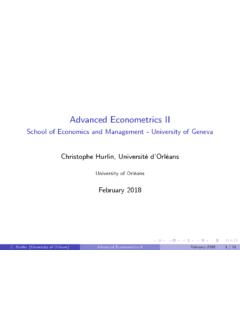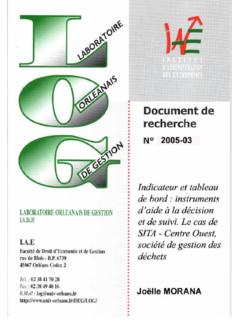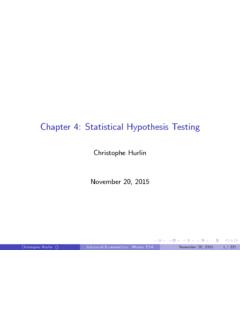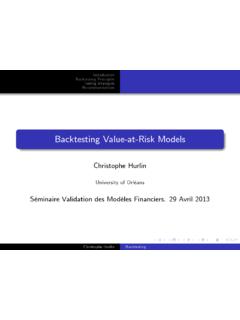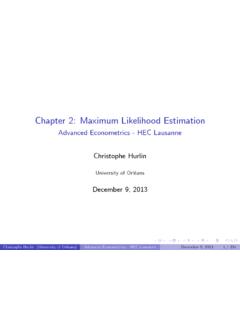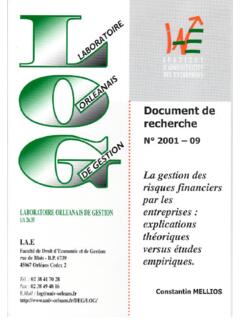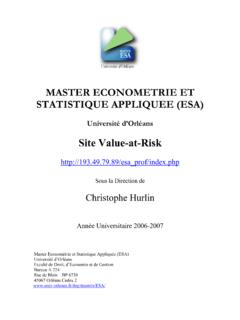Transcription of Chapter 2. Dynamic panel data models - univ …
1 Chapter 2. Dynamic panel data modelsSchool of Economics and Management - University of GenevaChristophe Hurlin, Universit of Orl ansUniversity of Orl ansApril 2018C. Hurlin (University of Orl ans)Advanced Econometrics IIApril 20181 / 2091. IntroductionDe nition ( Dynamic panel data model)We now consider a Dynamic panel data model, in the sense that it contains(at least) one lagged dependent variables. For simplicity, let us consideryit= yi,t 1+ 0xit+ i+ itfori=1,..,nandt=1,..,T. iand tare the (unobserved) individualand time-speci c e ects, and itthe error (idiosyncratic) term withE( it)=0, and E( it js)= 2 ifj=iandt=s,and E( it js)= Hurlin (University of Orl ans)Advanced Econometrics IIApril 20182 / 2091.
2 IntroductionRemarkIn a Dynamic panel model, the choice between a xed-e ects formulationand a random-e ects formulation has implications for estimation that areof adi erent naturethan those associated with the static Hurlin (University of Orl ans)Advanced Econometrics IIApril 20183 / 2091. IntroductionDynamic panel issues1If lagged dependent variables appear as explanatory variables, strictexogeneity of the regressors no longer holds. TheLSDV is no longerconsistent whenntends to in nity andTis values of a Dynamic processraise another problem.
3 Itturns out that with a random-e ects formulation, the interpretationof a model depends on the assumption of initial consistency property of the MLE and the GLS estimator alsodepends on the way in whichTandntend to in Hurlin (University of Orl ans)Advanced Econometrics IIApril 20184 / 209 IntroductionThe outline of this Chapter is the following:Section 1:IntroductionSection 2: Dynamic panel biasSection 3:The IV (Instrumental Variable) approachSubsection :Reminder on IV and 2 SLSS ubsection :Anderson and Hsiao (1982) approachSection 4:The GMM (Generalized Method of Moment) approachSubsection :General presentation of GMMS ubsection :Application to Dynamic panel data modelsC.
4 Hurlin (University of Orl ans)Advanced Econometrics IIApril 20185 / 209 Section 2 The Dynamic panel BiasC. Hurlin (University of Orl ans)Advanced Econometrics IIApril 20186 / 2092. The Dynamic panel biasObjectives1 Introduce theAR(1) panel data the semi-asymptotic bias of theLSDV the sources of thedynamic panel biasorNickell s themagnitudeof this bias in a simple AR(1) this bias byMonte Hurlin (University of Orl ans)Advanced Econometrics IIApril 20187 / 2092. The Dynamic panel biasDynamic panel bias1 The LSDV estimator is consistent for the static model whether thee ects are xed or the contrary, the LSDV is inconsistent for a Dynamic panel datamodel with individual e ects, whether the e ects are xed or Hurlin (University of Orl ans)Advanced Econometrics IIApril 20188 / 2092.
5 The Dynamic panel biasDe nition (Nickell s bias)The biais of the LSDV estimator in a Dynamic model is generaly known asdynamic panel bias or Nickell s bias (1981).Nickell, S. (1981). Biases in Dynamic models with Fixed E ects,Econometrica, 49, 1399 , , and C. Hsiao (1982). Formulation and Estimation ofDynamic models Using panel data ,Journal of Econometrics, 18, 47 Hurlin (University of Orl ans)Advanced Econometrics IIApril 20189 / 2092. The Dynamic panel biasDe nition (AR(1) panel data model)Consider the simple AR(1)modelyit= yi,t 1+ i+ itfori=1.
6 ,nandt=1,.., simplicity, let us assume that i= + ito avoid imposing the restriction that ni=1 i=0 orE( i)=0 in thecase of random individual e Hurlin (University of Orl ans)Advanced Econometrics IIApril 201810 / 2092. The Dynamic panel biasAssumptions1 The autoregressive parameter satis esj j<12 The initial conditionyi0is error term satis es withE( it)=0, andE( it js)= 2 ifj=iandt=s,andE( it js)=0 Hurlin (University of Orl ans)Advanced Econometrics IIApril 201811 / 2092. The Dynamic panel biasDynamic panel biasIn this AR(1) panel data model, we will show thatplimn!
7 B LSDV6= Dynamic panel biasplimn,T! b LSDV= C. Hurlin (University of Orl ans)Advanced Econometrics IIApril 201812 / 2092. The Dynamic panel biasThe LSDV estimator is de ned by (cf. Chapter 1)b i=yi b LSDVyi, 1b LSDV= n i=1T t=1(yi,t 1 yi, 1)2! 1 n i=1T t=1(yi,t 1 yi, 1)(yit yi)!xi=1TT t=1xityi=1TT t=1yityi, 1=1TT t=1yi,t 1C. Hurlin (University of Orl ans)Advanced Econometrics IIApril 201813 / 2092. The Dynamic panel biasDe nition (bias)The bias of the LSDV estimator is de ned by:b LSDV = n i=1T t=1(yi,t 1 yi, 1)2!
8 1 n i=1T t=1(yi,t 1 yi, 1)( it i)!C. Hurlin (University of Orl ans)Advanced Econometrics IIApril 201814 / 2092. The Dynamic panel biasThe bias of the LSDV estimator can be rewritten as:b LSDV =n i=1T t=1(yi,t 1 yi, 1)( it i)/(nT)n i=1T t=1(yi,t 1 yi, 1)2/(nT)C. Hurlin (University of Orl ans)Advanced Econometrics IIApril 201815 / 2092. The Dynamic panel biasLet us consider the numerator. Because itare (1) uncorrelated with iand (2) are independently and identically distributed, we haveplimn! 1nTn i=1T t=1(yi,t 1 yi, 1)( it i)=plimn!
9 1nTT t=1n i=1yi,t 1 it|{z}N1 plimn! 1nTT t=1n i=1yi,t 1 i|{z}N2 plimn! 1nTT t=1n i=1yi, 1 it|{z}N3+plimn! 1nTT t=1n i=1yi, 1 i|{z}N4C. Hurlin (University of Orl ans)Advanced Econometrics IIApril 201816 / 2092. The Dynamic panel biasTheorem (Weak law of large numbers, Khinchine)IffXig,for i=1,..,m is a sequence of random variables withE(Xi)= < , then the sample mean converges in probability to :1mm i=1 Xip!E(Xi)= orplimm! 1mm i=1Xi=E(Xi)= C. Hurlin (University of Orl ans)Advanced Econometrics IIApril 201817 / 2092.
10 The Dynamic panel biasBy application of the WLLN (Khinchine s theorem)N1=plimn! 1nTn i=1T t=1yi,t 1 it=E(yi,t 1 it)Since (1)yi,t 1only depends on i,t 1, i,t 2and (2) the itareuncorrelated, then we haveE(yi,t 1 it)=0and nallyN1=plimn! 1nTn i=1T t=1yi,t 1 it=0C. Hurlin (University of Orl ans)Advanced Econometrics IIApril 201818 / 2092. The Dynamic panel biasFor the second termN2, we have:N2=plimn! 1nTn i=1T t=1yi,t 1 i=plimn! 1nTn i=1 iT t=1yi,t 1=plimn! 1nTn i=1 iTyi, 1asyi, 1=1TT t=1yi,t 1=plimn! 1nn i=1 iyi, 1C.
